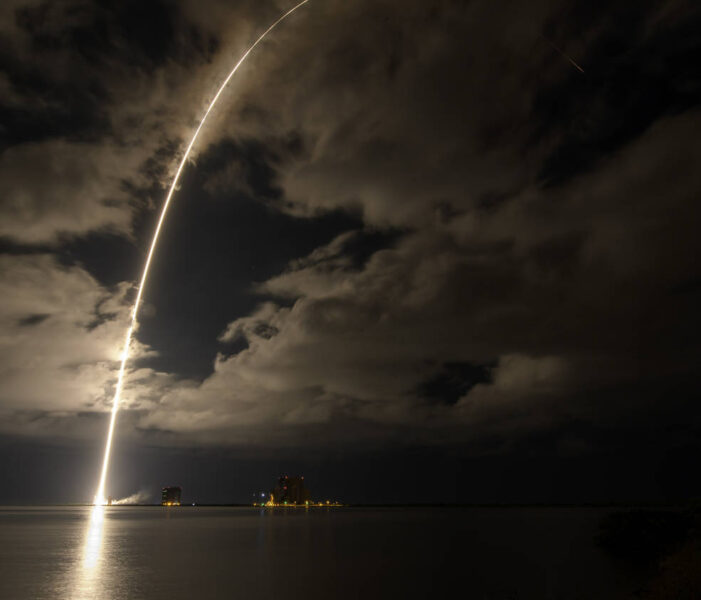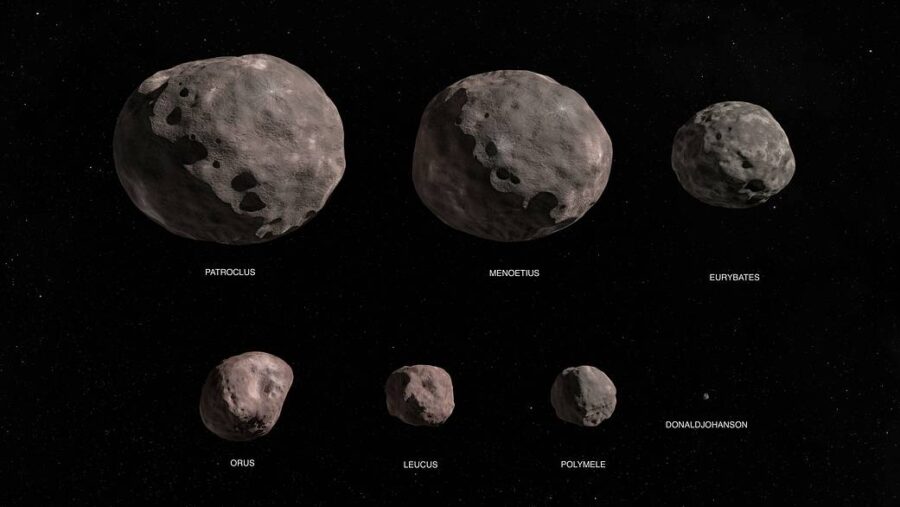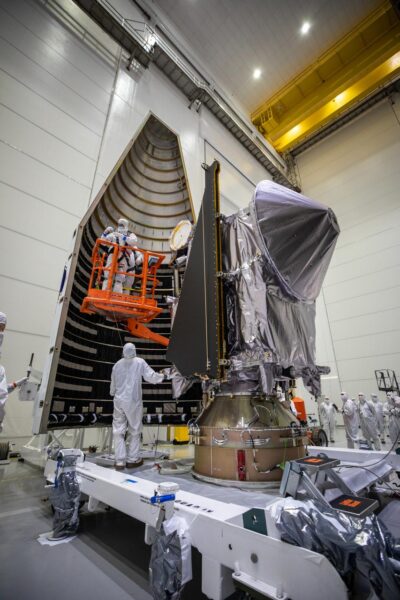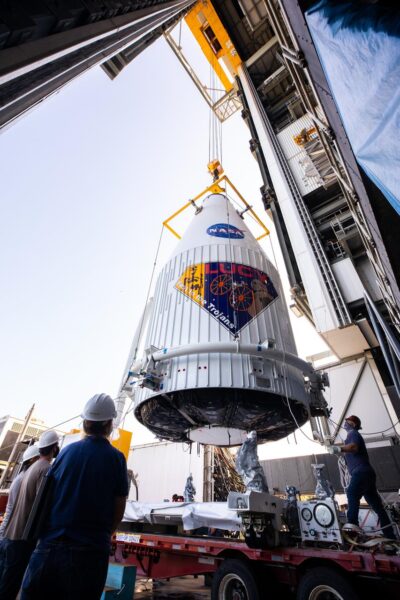NASA’s ambitious Lucy mission has launched to explore Jupiter’s Trojan asteroids, pristine examples of the solar system’s early years.

NASA / Bill Ingalls
Update (Monday, October 18th): While Lucy's solar panels deployed and are currently generating power, NASA reports that one panel did not latch correctly. the team is currently analyzing the situation. Meanwhile, University of Alabama Astronomical Society students caught Lucy on its outbound flight from Earth:
Outbound! @LucyMission from @UofAlabama campus observatory 0.4m telescope, w/UA Astro Society students after their Intl. Observe the Moon session. 36-minute timespan, mean distance 350,000 km. pic.twitter.com/zo2pUmLTtD
— William Keel (@NGC3314) October 17, 2021
A United Launch Alliance lit up the dawn sky over launchpad SLC-41 at Cape Canaveral Space Force Station this morning, sending NASA’s Lucy mission on its way to explore Jupiter's Trojan asteroids. These space rocks orbit 60 degrees ahead and behind of Jupiter in its orbit. Liftoff occurred at 9:34 UT / 5:34 a.m. EDT. Lucy is one of the top planetary missions to depart Earth in 2021.
The launch was flawless, and ground control reported the spacecraft to be in good health. The solar panels unfurled as the second-stage booster lofted the mission into a heliocentric orbit. After an Earth flyby in late 2024, Lucy will visit one main-belt asteroid (52246 Donaldjohanson) and seven Trojan bodies from 2025 to 2033. The Trojans form two groups, sometimes dubbed ‘camps,’ that commemorate the two sides of the Trojan War: the Greek camp leading Jupiter at the stable L4 point 60° ahead of its position, and the Trojan camp trailing 60° behind Jupiter in its orbit.

NASA
The mission timeline will see the Lucy mission taking a convoluted path through the inner solar system. After passing Donaldjohanson, named for the paleo-anthropologist who discovered the Lucy fossil, Lucy will go on to the Greek camp. First up is 3548 Eurybates and its moon in August 2027, 15094 Polymele in September 2027, 11351 Leucus in April 2028, and 21900 Orus in November 2028.
Then, after an Earth flyby the day after Christmas 2030, Lucy will head for the camp of Trojans behind Jupiter in its orbit, reaching a large pair named 617 Patroclus-Menoetius on March 2, 2033. These final targets are on a high-inclination orbit around the Sun, making for a challenging approach. The team was fortunate that the timing works out to catch Patroclus as it passes through the ecliptic plane.
"Lucy embodies NASA's enduring quest to push out into the cosmos for the sake of exploration and science, to better understand the universe and our place within it," says NASA administrator Bill Nelson in a recent press release. "I can't wait to see what mysteries the mission uncovers!"

NASA
Why Explore the Trojans
These asteroids have likely been trapped in their current orbits for billions of years. They thus represent pristine examples of material leftover from the formation of the solar system. Lucy will investigate the geology, composition, and interiors of the rocks to shed light on planet formation processes. Several of the asteroids targeted are C-type carbonaceous asteroids, and a few are suspected binaries or possess known moonlets.
The Lucy team is looking for motivated observers to follow occasions when target asteroids occult (block) background stars. Amateur and professional observations alike can help get a better idea of the shapes and orbits of these asteroids. Unistellar also has an ongoing campaign for eQuinox and eVscope2 users to monitor occultations on target asteroids pre-flyby.

NASA/SWRI
Lucy takes its name from the 3.2 million-year-old hominid skeleton found in 1974 in the Awash Valley in Ethiopia, Africa, whose name was in turn inspired by the Beatles song "Lucy in the Sky With Diamonds."
The $981 million mission was one of two Discovery Class missions selected in 2017. The second mission, named Psyche, is headed to the iron-rich asteroid also named 16 Psyche and will launch next summer.
Lucy is solar powered, the second mission along with Juno to venture out as far as Jupiter’s orbit using solar panels for power instead of traditional plutonium-fueled generators.

NASA/Ben Smegelsky
Lucy carries four instruments:
L’LORRI – This high-resolution imager will photograph the asteroids in visible light providing detailed maps of their surfaces. Built by Johns Hopkins University Applied Physics Laboratory, it's a duplicate of the LORRI Long Range Reconnaissance Imager aboard New Horizons.
L’Ralph – Built at the Goddard Flight Center, this suite consists of a visible-light imager, , similar to the Ralph imager on New Horizons, and an infrared spectrometer. The duo will help determine the compositions of the asteroids' surfaces.
L’TES – This thermal-emission spectrometer, designed by Arizona State University, will examine the heat given off by asteroids, shedding light on their interior structures Also a spaceflight-proven technology, L'TES is similar to the OTES instrument aboard OSIRIS-REX.

NASA / Isaac Watson
After the final flyby in 2033, Lucy may be granted a mission extension, but will otherwise remain in a stable, 6-year orbit between the two Trojan camps. Knowing this, mission planners attached a plaque to Lucy, which includes 20 samples of poetry and quotations from luminaries including Martin Luther King Jr., Carl Sagan, and the Beatles. The plaque also shows the orbital configuration of the planets of solar system at launch, plus the path of Lucy, and the geological position of the continents of the Earth at the time of launch for any would-be spacecraft salvagers, thousands or millions of years in the future.

NASA/SwRI
It's amazing to think that Lucy's legacy, delving billions of years into the past, will also extend far into the future.
 1
1









Comments
Anthony Barreiro
October 16, 2021 at 5:52 pm
This page has the text of the quotations on the plaque.
http://lucy.swri.edu/LucyPlaque.html
Not bad, considering they were selected by a bunch of engineers. 😉
Best wishes to the Lucy mission.
And I hope now that our former President is our former President, the US will get back into compliance with the Convention on the Peaceful Uses of Outer Space and quietly abandon the silly idea of a Space Force.
You must be logged in to post a comment.
You must be logged in to post a comment.